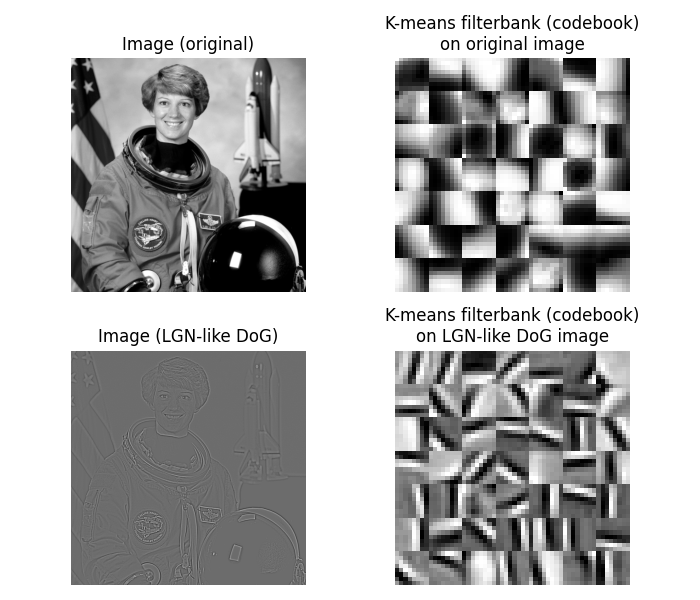Note
Go to the end to download the full example code or to run this example in your browser via Binder
Gabors / Primary Visual Cortex “Simple Cells” from an Image#
How to build a (bio-plausible) sparse dictionary (or ‘codebook’, or ‘filterbank’) for e.g. image classification without any fancy math and with just standard python scientific libraries?
Please find below a short answer ;-)
This simple example shows how to get Gabor-like filters [1] using just a simple image. In our example, we use a photograph of the astronaut Eileen Collins. Gabor filters are good approximations of the “Simple Cells” [2] receptive fields [3] found in the mammalian primary visual cortex (V1) (for details, see e.g. the Nobel-prize winning work of Hubel & Wiesel done in the 60s [4] [5]).
Here we use McQueen’s ‘kmeans’ algorithm [6], as a simple biologically plausible hebbian-like learning rule and we apply it (a) to patches of the original image (retinal projection), and (b) to patches of an LGN-like [7] image using a simple difference of gaussians (DoG) approximation.
Enjoy ;-) And keep in mind that getting Gabors on natural image patches is not rocket science.

/opt/hostedtoolcache/Python/3.9.16/x64/lib/python3.9/site-packages/scipy/cluster/vq.py:602: UserWarning:
One of the clusters is empty. Re-run kmeans with a different initialization.
from scipy.cluster.vq import kmeans2
from scipy import ndimage as ndi
import matplotlib.pyplot as plt
from skimage import data
from skimage import color
from skimage.util.shape import view_as_windows
from skimage.util import montage
patch_shape = 8, 8
n_filters = 49
astro = color.rgb2gray(data.astronaut())
# -- filterbank1 on original image
patches1 = view_as_windows(astro, patch_shape)
patches1 = patches1.reshape(-1, patch_shape[0] * patch_shape[1])[::8]
fb1, _ = kmeans2(patches1, n_filters, minit='points')
fb1 = fb1.reshape((-1,) + patch_shape)
fb1_montage = montage(fb1, rescale_intensity=True)
# -- filterbank2 LGN-like image
astro_dog = ndi.gaussian_filter(astro, .5) - ndi.gaussian_filter(astro, 1)
patches2 = view_as_windows(astro_dog, patch_shape)
patches2 = patches2.reshape(-1, patch_shape[0] * patch_shape[1])[::8]
fb2, _ = kmeans2(patches2, n_filters, minit='points')
fb2 = fb2.reshape((-1,) + patch_shape)
fb2_montage = montage(fb2, rescale_intensity=True)
# -- plotting
fig, axes = plt.subplots(2, 2, figsize=(7, 6))
ax = axes.ravel()
ax[0].imshow(astro, cmap=plt.cm.gray)
ax[0].set_title("Image (original)")
ax[1].imshow(fb1_montage, cmap=plt.cm.gray)
ax[1].set_title("K-means filterbank (codebook)\non original image")
ax[2].imshow(astro_dog, cmap=plt.cm.gray)
ax[2].set_title("Image (LGN-like DoG)")
ax[3].imshow(fb2_montage, cmap=plt.cm.gray)
ax[3].set_title("K-means filterbank (codebook)\non LGN-like DoG image")
for a in ax.ravel():
a.axis('off')
fig.tight_layout()
plt.show()
Total running time of the script: ( 0 minutes 1.030 seconds)